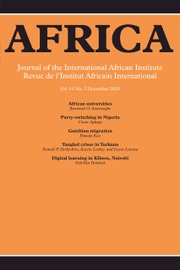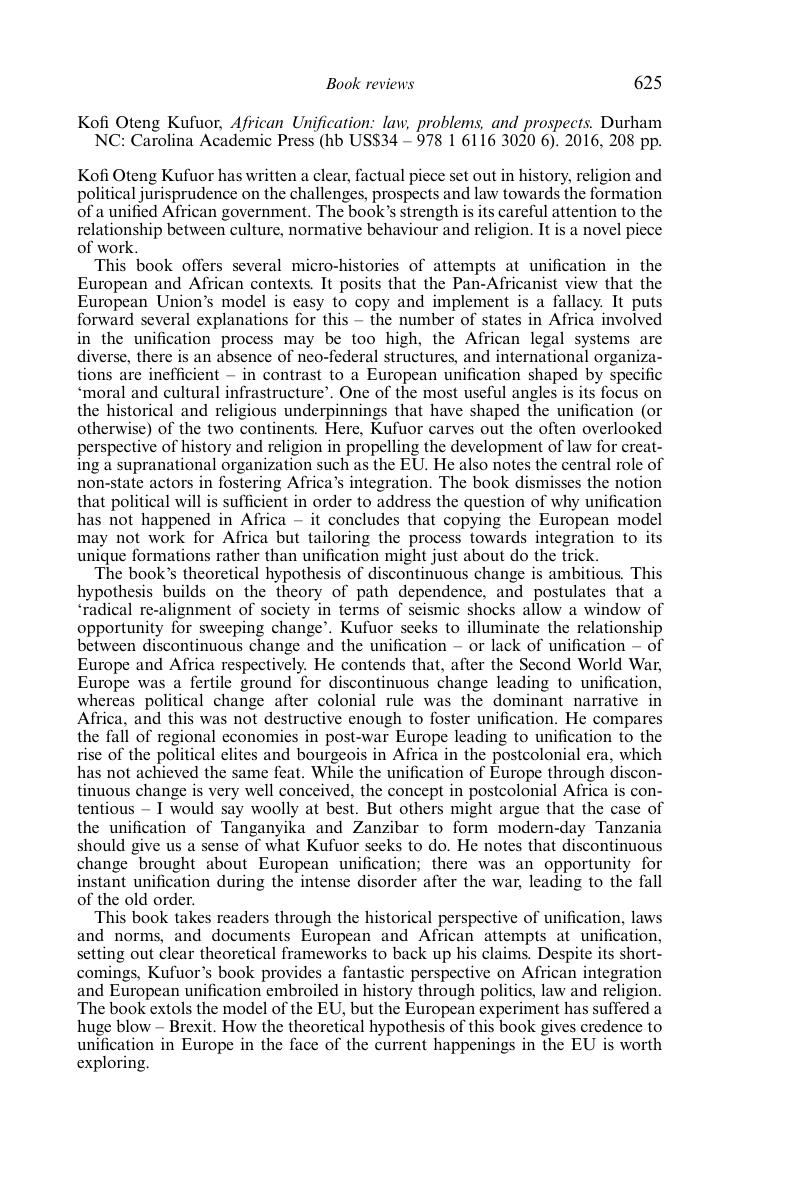Kofi Oteng Kufuor has written a clear, factual piece set out in history, religion and political jurisprudence on the challenges, prospects and law towards the formation of a unified African government. The book's strength is its careful attention to the relationship between culture, normative behaviour and religion. It is a novel piece of work.
This book offers several micro-histories of attempts at unification in the European and African contexts. It posits that the Pan-Africanist view that the European Union's model is easy to copy and implement is a fallacy. It puts forward several explanations for this – the number of states in Africa involved in the unification process may be too high, the African legal systems are diverse, there is an absence of neo-federal structures, and international organizations are inefficient – in contrast to a European unification shaped by specific ‘moral and cultural infrastructure’. One of the most useful angles is its focus on the historical and religious underpinnings that have shaped the unification (or otherwise) of the two continents. Here, Kufuor carves out the often overlooked perspective of history and religion in propelling the development of law for creating a supranational organization such as the EU. He also notes the central role of non-state actors in fostering Africa's integration. The book dismisses the notion that political will is sufficient in order to address the question of why unification has not happened in Africa – it concludes that copying the European model may not work for Africa but tailoring the process towards integration to its unique formations rather than unification might just about do the trick.
The book's theoretical hypothesis of discontinuous change is ambitious. This hypothesis builds on the theory of path dependence, and postulates that a ‘radical re-alignment of society in terms of seismic shocks allow a window of opportunity for sweeping change’. Kufuor seeks to illuminate the relationship between discontinuous change and the unification – or lack of unification – of Europe and Africa respectively. He contends that, after the Second World War, Europe was a fertile ground for discontinuous change leading to unification, whereas political change after colonial rule was the dominant narrative in Africa, and this was not destructive enough to foster unification. He compares the fall of regional economies in post-war Europe leading to unification to the rise of the political elites and bourgeois in Africa in the postcolonial era, which has not achieved the same feat. While the unification of Europe through discontinuous change is very well conceived, the concept in postcolonial Africa is contentious – I would say woolly at best. But others might argue that the case of the unification of Tanganyika and Zanzibar to form modern-day Tanzania should give us a sense of what Kufuor seeks to do. He notes that discontinuous change brought about European unification; there was an opportunity for instant unification during the intense disorder after the war, leading to the fall of the old order.
This book takes readers through the historical perspective of unification, laws and norms, and documents European and African attempts at unification, setting out clear theoretical frameworks to back up his claims. Despite its shortcomings, Kufuor's book provides a fantastic perspective on African integration and European unification embroiled in history through politics, law and religion. The book extols the model of the EU, but the European experiment has suffered a huge blow – Brexit. How the theoretical hypothesis of this book gives credence to unification in Europe in the face of the current happenings in the EU is worth exploring.
The African Union's Continental Free Trade Agreement (CFTA) was signed by forty-four African nations at an extraordinary summit in Kigali – but ten countries have abstained from the deal so far. Supporters of the CFTA argue that it will create larger, more competitive markets, helping Africa escape the colonial legacy and move towards unification. But the African Union's CFTA, which has been touted as the catalyst for the formation of an African government, seems to be in direct opposition to the central hypothesis Kufuor seeks to explore in this book, since it has not followed a non-incremental, sudden change that would threaten the power structure.
All projects have their limitations, and this book stops short of exploring in any depth the cooperation between private actors in trade through acceptable and efficient norms, or how the trade agenda has taken precedence over the more elusive objective of an inclusive African government or the idea of African unification more generally. Nevertheless, the debate between supranationalism and national sovereignty in this book will hold readers spellbound.



